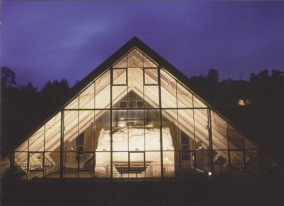Als „Birthplace of Industry“ gehört das Severn-Tal von Coalbrookdale heute zu den weltweit bedeutendsten Denkmalen der Industriegeschichte mit einer Vielzahl einzelner Sehenswürdigkeiten und Museen unter dem Dach des Ironbridge Gorge Museum Trust (www.ironbridge.org.uk [1]).
Anläßlich des Jubiläums bietet der Trust nach eigenen Angaben zahlreiche Veranstaltungen. Neugestaltet wurde die Ausstellung im „Museum of Iron“. Seit Ostern 2009 zeigt The Coalbrookdale Gallery zahlreiche künstlerische Darstellungen des Tales und seiner Werke, basierend auf der Elton Collection, ergänzt durch zahlreiche, teil selten gezeigte Leihgaben. Am letzten Juliwochenende findet das „Coalbrookdale Festival“ statt. Vom 7. bis 10. August treffen sich im Blists Hill-Freilichtmuseum englische Kunstschmiede im Rahmen eines „forge in“, um die Atmosphäre einer viktorianischen Industriestadt wiederentstehen zu lassen. Das Festjahr ist auch Anlaß zur bis Juli andauernden Sanierung der archäologischen Stätte mit den Ruinen des Darby-Hochofens. Seit Beginn der 1980er Jahre wird der erhaltene Teil des Hochofens von einem Schutzdach überdeckt.

Ein Höhepunkt der Feiern ist der Kongress „Footprints of Industry“. Als „mayor academic conference“ angekündigt, soll vom 3. bis 6. Juni am Ort des ersten Kokshochofens ein Panorama der Industriearchäologie gezeichnet werden.
DRAFT PROGRAMME
DAY ONE: THURSDAY 4TH JUNE 2009
THE ORIGINS OF INDUSTRIALISATION AND THE INHERITANCE OF ABRAHAM DARBY
Farms to Forges: early medieval industrialisation in Europe: Ronald A. Ross (Wilfred Laurier University, Ontario)
Iron, glass, and castles: the medieval industrial landscape in southern Germany: Gerhard Ermischer (Archaeologisches Spessart-Project, Germany)
Ancient copper and lead pollution records from peat bogs in Central Wales and Scotland: Tim Mighall et al. (Universities of Aberdeen, Cambridge, Westminster, Leeds and Edinburgh)
Monastic Scotland not Quaker Coalbrookdale?: Salt and the ‘long Industrial Revolution’: David Cranstone (Cranstone Consultants)
The early iron industry in the English west midlands: Peter King (Independent Researcher)
Before the Lunar Society: the evidence for early post-medieval industrialisation in Birmingham: Chris Hewitson (University of Birmingham)
Some Brayon and Walloon interventions at Coalbrookdale: Brian G. Awty (Independent Researcher)
The Industrial and Social Impact of John Wilkinson: Vin Callcut (Independent Researcher)
Industrialisation: Some thoughts on Archaeological Evidence from the Manchester Region: Mike Nevell (University of Manchester)
DAY 2: FRIDAY 5TH JUNE 2009
TOWARDS BRAVE NEW WORLDS: TECHNOLOGY, SOCIETY AND GLOBALISATION
C’est en forgeant qu’on devient forgeron: cognitive archaeology and metalworking: David Dungworth (English Heritage)
Dressing ore in a mining backwater, 1405 to 1930: continuity through conservatism or change through ‘tweaking’?: Phil Newman (English Heritage)
Religion, science and technology in the sixteenth, seventeenth and eighteenth centuries: Paul Belford (Ironbridge Gorge Museum Trust)
Puddling: A Metallurgical Perspective: Merton C. Flemings (Massachusetts Institute of Technology)
Advancing the work of Prometheus – the impact of artificial light in the workplace and beyond: Ian West (University of Leicester)
New men on the block – Sheffield steelmen in the Cutlers’ Company:Joan Unwin (Company of Cutlers in Hallamshire)
Living through the industrial revolution: disease and death in 18th and 19th century Birmingham: Megan Brickley (University of Birmingham)
Smelting works, chapels, churches, institutes and houses: Stephen Hughes (Royal Commission on the Ancient & Historical Monuments of Wales)
Bound to the Margins of Society: West Yorkshire Workhouses of the Industrial Age: Charlotte Newman (University of York)
The Shock of the New: technology and change in London’s East End: Emma Dwyer (Museum of London Archaeology)
Bath in the Industrial Revolution: the Harmony of Tourism, Trade, and Innovation: C. J. Axon (University of Oxford) and Stuart Burroughs (Museum of Bath at Work)
Steel Away – the Trenton Steel Works and the Struggle for American Manufacturing Independence: Richard W. Hunter and Ian C. Burrow (Hunter Research Inc.)
Keynote lecture: Marilyn Palmer
DAY 3: SATURDAY 6TH JUNE 2009
UNDERSTANDING, MANAGING AND INTERPRETING THE HERITAGE OF INDUSTRIALISATION
Detritus or Waste? Approaches to preservation and presentation of 19th and 20th century industrial workshops: William Mitchell (University of Birmingham)
It’s not just the Buildings: Approaches to improving appreciation of Ironworks in their landscapes in South Wales: Andrew G Marvell (Glamorgan-Gwent Archaeological Trust)
The Clee Hills: concrete heritage, missed opportunities and an extraordinary landscape: Roger White (University of Birmingham)
Industrial Heritage in the Greater Region: Norbert Mendgen (HTW des Saarlandes)
Industrial heritage in Spain: national plan and concrete examples: Pablo Sánchez (University of Valladolid / Llámpara Association)
Apocalypse Soon: a seedbank of of technologies as part of the human survival package?: David Cranstone (Cranstone Consultants)
So much archaeology, so little time: archaeological technique and Industrial remains: Helen Gomersall (West Yorkshire Archaeology Advisory Service)
Concluding lecture: Bringing Back The People; Sir Neil Cossons
Aktuelle und detaillierte Informationen unter: www.ironbridge.org.uk [2]

Die europäische Perspektive: Projekt Early Birthplaces
Ironbridge ist auch wichtiger Bestandteil des Projektes „Early Birthplaces“ (www.early-birthplaces.eu [3]) , in dem europaweit die vor- und frühindustrielle Entwicklung der Roheisenerzeugung dokumentiert und präsentiert wird – unter maßgeblicher Beteiligung des LVR-Industriemuseums, Schauplatz Oberhausen.